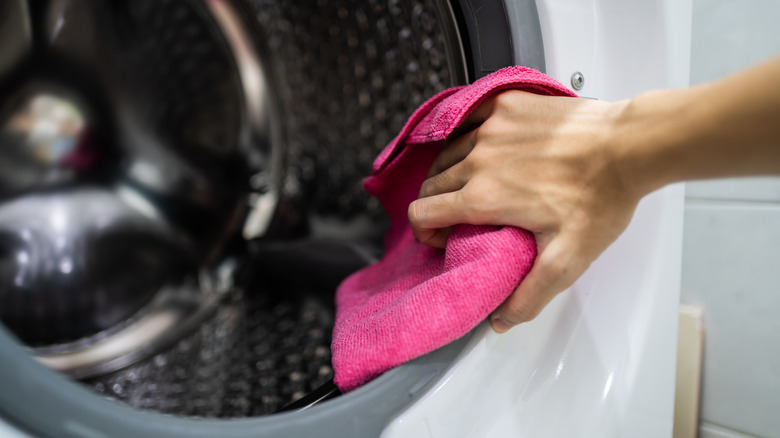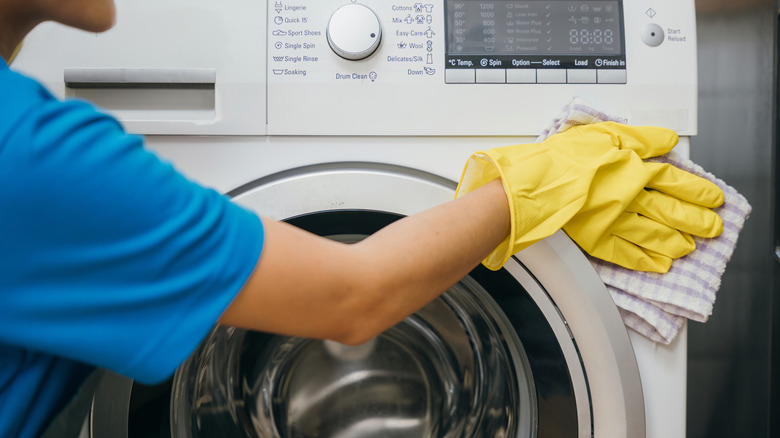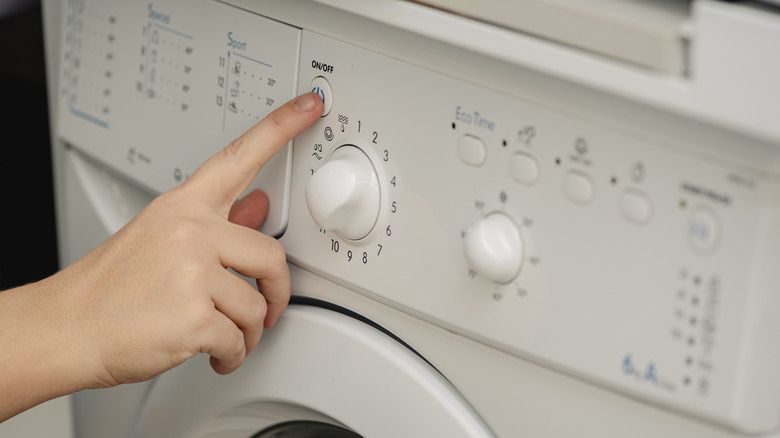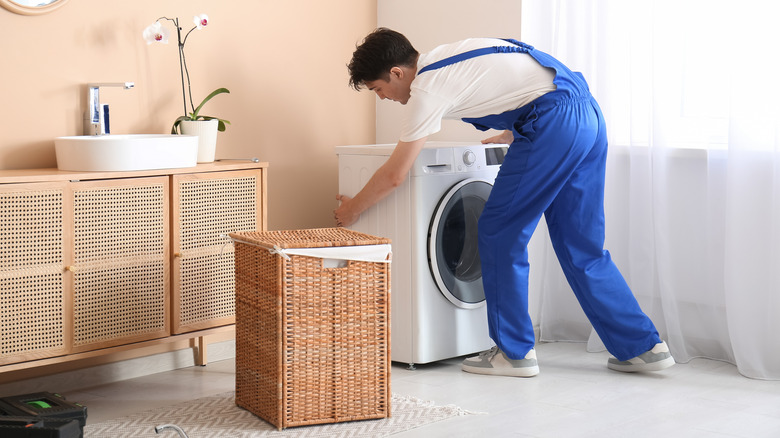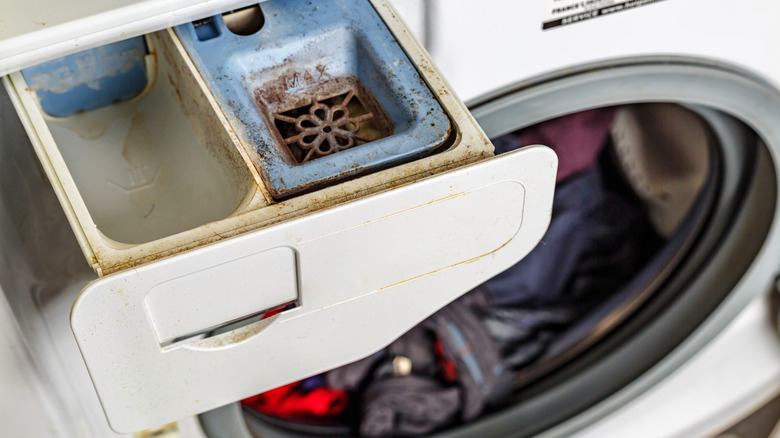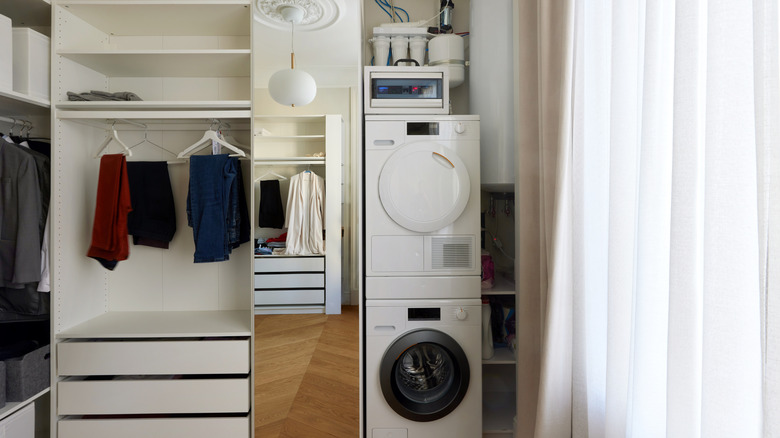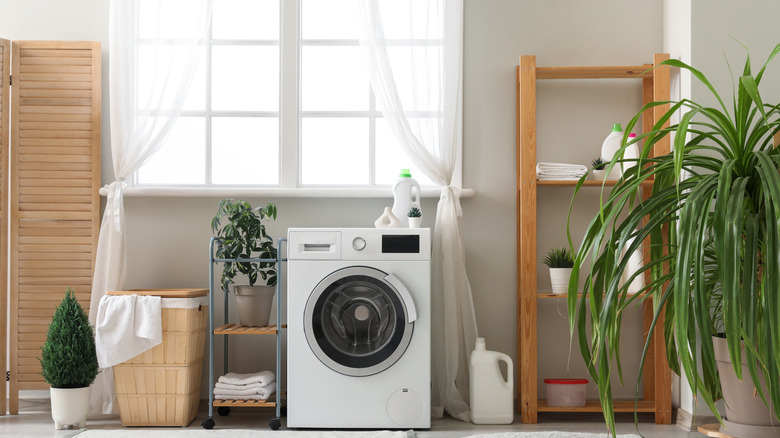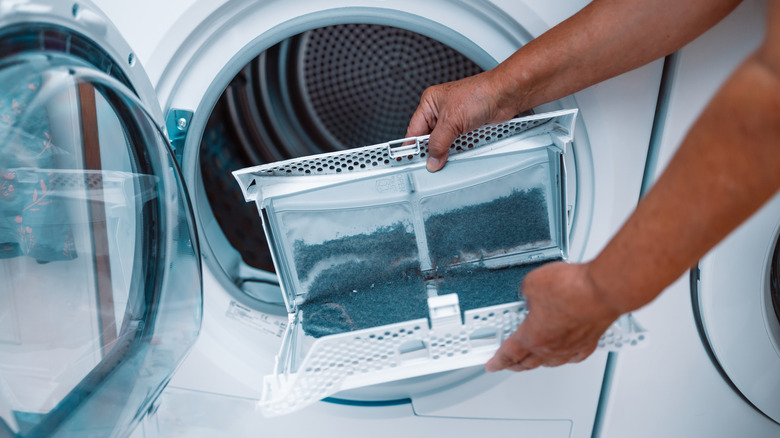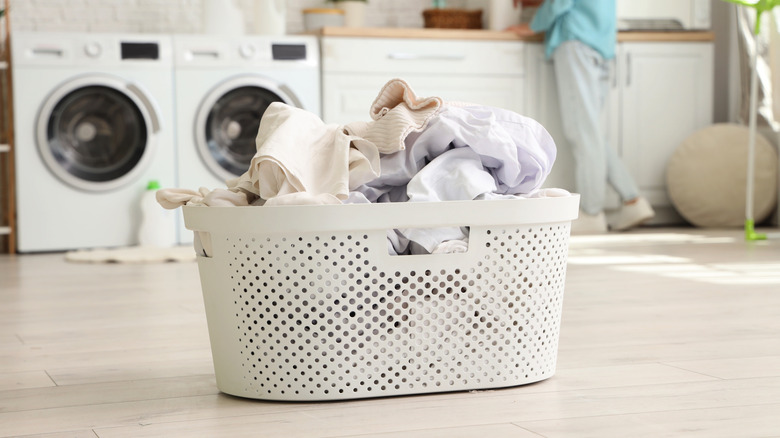The Overlooked Laundry Room Areas You're Probably Forgetting To Clean
We may receive a commission on purchases made from links.
When you stop to think about it, a functional laundry room is a treat if you're lucky to have one in your home. However, you might not feel so lucky when it's time to deep clean the space, especially since it's something that's easy to overlook. After all, your laundry comes out of the room clean, and there's a whole lot of soap being used there. How dirty can it be? Well, all those clothes that you cycle through could be contaminated with bacteria, viruses, dirt, bodily fluids, and other gross particles. Not only are you battling those mostly invisible invaders, but the laundry room is also a common collection spot for dust bunnies and dryer lint. And there are several hidden or lesser-thought-about spots that don't get cleaned often: the machines themselves, corners, lint traps, laundry baskets, and windows, just to name a few.
Whether you like it or not, you likely end up spending a lot of time in your laundry room. And you want the clean clothes that come out of your dryer to stay clean. That's why it's important to do a deep clean now and then to tackle those forgotten spots. You'll notice other possible benefits as well. It can make your laundry process more efficient, increase the life of your appliances, improve hygiene, and make laundry a little less stressful. So, grab your cleaning supplies and head to the laundry room with this list of overlooked spots that you should clean.
The exterior of your washer and dryer
The dirty clothes go inside your washing machine, but the exterior of the units can still get dirty. If you've ever tossed a pile of dirty clothes on top of the washer or dryer, any contaminants on them can transfer to the surface. The little lint fibers from the dryer also have a tendency to collect on the machines, and you might also have to contend with dust, pet hair, and any other loose particles. They're also a prime target for splashes of detergent, bleach, fabric softener, and stain remover. Cleaning up the gunk can keep your clothes from getting dirty again or even being ruined. For example, a splash of bleach sitting on your washing machine could cause a faded spot on your favorite tank top.
Dust your washer and dryer whenever they need it. You can usually spot lint particles easily as a sign that it's time to clean them. It's also important to wipe up any detergent or bleach spills immediately to keep them from transferring to clothes or solidifying and becoming more difficult to clean. Beyond those immediate needs, get in the habit of wiping the exterior of your washer and dryer weekly with a damp cloth to keep them in good shape. Avoid any harsh chemicals, which could damage or dull the finish. Instead, use a little gentle soap or multipurpose spray if needed to get the surface clean. Don't forget the control panel, gaskets, and crevices on the machines. A soft-bristled cleaning brush or toothbrush works well to gently remove gunk from those areas. Then, dry off the machine when you're done cleaning.
The interior of your washer and dryer
It's logical to think the insides of your machines don't need much attention. After all, doesn't your washing machine get cleaned along with the clothes? And the items you put in the dryer are already clean. But it's still possible for gunk to build up on the inside of your washing machine. You may find soap scum, detergent residue, and dirt from the clothes lingering inside the tub. Your dryer can also end up with gunk inside the drum that can then transfer onto fabrics. Regularly cleaning those interior spaces can keep your laundry machines more sanitary and prevent damage to your clothes. Add this task to your monthly laundry room checklist (or after roughly every 30 uses of the machine).
To clean the inside of the washer, you'll want to run an empty cycle with a cleaning agent. You can purchase products, like Seventh Generation's Washing Machine Cleaner, that you use with a specific cycle. Or, use items you have in your pantry. Baking soda works well as a gentle scouring agent to clean away visible gunk in the empty drum of your washer. When you're done, turn the washing machine to the hottest and largest setting to fill, and then add 2 to 4 cups of white vinegar, letting it agitate for a few minutes. Stop the cycle so the vinegar water can sit for an hour or longer, and then let the cycle finish. For the inside of your dryer, dip a cleaning cloth into soapy water, and wipe the drum. Then, use a clean, damp cloth to wipe away the soapy water. If you have ink stains, rubbing alcohol can help remove the marks. Just wipe down the surface after with a clean, damp cloth and allow it to dry well.
Underneath the machines
The floor under your washer and dryer might not be as bad as behind the stove or refrigerator. But it can still get dirtier than you realize with all of the dust bunnies, dryer lint, and other debris that gathers in your laundry room. Eventually, that gunk could start to creep out from underneath the machines and make the rest of the room dirtier. Cleaning the areas underneath the machines at least twice a year should be enough unless your laundry room is busy and tends to get dirtier than others.
To fully clean under the machines, pull them away from the wall, being careful not to overstretch the hoses or cords. Vacuum or sweep up the floor. Then, follow up with a soapy mop to remove any additional grime. Once the floor is dry, move the laundry room appliances back into their spots. If you don't want to move them or can't safely do so, you can clean underneath and behind them where they sit. Try a vacuum cleaner with a long, narrow attachment or a microfiber gap cleaner, like IvyRoll's Skinny Duster with Extension, which is a flat dusting tool with a telescopic handle. You can run these cleaning tools underneath and behind the machines to get as much dirt out as possible.
Inside the washing machine detergent drawer
When you're trying to figure out the best way to clean your washing machine, don't forget about the detergent drawers. Washing machines have assorted compartments and drawers that hold detergent, bleach, fabric softener, and other laundry additives. While those products help get your laundry fresh and clean, they can leave these dispensers gunky and in need of a good cleaning. Not only does it leave the machine looking gross, but it can also clog it up and make it smell bad. Cleaning those compartments when you notice the buildup can prevent those complications.
Many detergent drawers are removable, which makes them easier to clean. You may need to push a release lever or button to pull the drawer out completely. Soaking the drawers in warm, soapy water can help soften the buildup so it's easier to remove. Wipe the drawer with a soft cloth, and use a toothbrush or other small scrub brush to remove any stubborn areas. Then, rinse it well to remove all of the soap, and dry it before popping it back into the machine. It's also a good idea to wipe the housing for the drawer as detergent may get on those surfaces as well. If you can't remove the drawer, you can use a damp cloth or hot water and a toothbrush to clean it out. Then, dry the drawer when you're done.
Around the faucet handles, utility sinks, and connections
The plumbing fixtures within your laundry room are also easy to overlook. If you have a utility sink in the space, you might not notice when it starts to get gunky. But it's also easy for grime to build up around the base of the faucets and the drain without being super noticeable. If you use that sink for soaking laundry or pre-treating stains, the grime could get on the clothes and cause a new issue. Your washing machine also has water connections where you might not think to clean, especially if they're hidden behind the unit. However, they can accumulate dust like other hidden spots in the laundry room.
When you pull your washer out to clean under it, look at the plumbing connections and water hoses to see if they need to be wiped. If you have a utility sink in the laundry room, regularly wiping it with a cloth and warm water can keep grime from building up. If you notice stains or gunk, add a little soap or all-purpose cleaner to help remove it. Diluted vinegar is another good cleaning agent for the sink. However, if you need a little more scrubbing power, make a paste with baking soda and water, and rub it onto the spot.
In the corners and tight spaces
You can find several clever ways to utilize small gaps in your laundry room for optimal storage. But those tiny areas, including the corners of the room, can also be a collecting spot for dust, lint, and debris. That's especially true if there's not much space between your laundry machines and the walls. You might not notice them since they're out of the way. It might not be until a stray sock falls off the edge of the dryer and into those corner crevices that you think to shine light on them. At that point, it's probably too late for the dropped laundry, which may need to be rewashed. But it's a good reminder to tackle those tight spots.
Give your corners a little attention every few months to keep them from breeding uncontrollable dust bunnies. If there's not much space between the corners and your laundry room appliances, you can use a long, thin vacuum attachment or the same microfiber gap duster you used to clean under your appliances. For laundry rooms with storage in the corner, use a slightly damp cloth to wipe off the top and shelves to remove the buildup.
Laundry room windows and tracks
Having at least one window in your laundry room brightens the space to help it feel larger. It can also give you better ventilation in a room that can get humid. A breeze through your laundry room window can even help line-dried clothes dry faster. However, your windows also provide another spot for lint and other gunk to settle. You'll likely notice when the glass starts to get a little hazy, but the window frames and tracks are easy to overlook. If you let too much debris build up in sliding laundry room windows, they might not move along the tracks as well as they used to. Opening your windows regularly can also allow little lint particles to build up on the screens, so they also need to be cleaned occasionally.
Whenever you dust your laundry room, add the windows and its parts to your list. Wipe the tracks with a damp cloth or use cleaning spray to remove stuck-on gunk. If your screens are dirty, vacuuming them can remove loose lint and particles. You may need to remove the screens and soak them in soapy water if they don't come clean easily. Then, spray the screens with a hose to rinse off the soapy water, and dry them before returning them to the laundry room windows.
The lint trap and vent hose
Sure, your dryer has a lint trap that collects a lot of the random fibers and particles from your clothes as they dry. But the lint doesn't always stay neatly on the screen. And, if you don't clean the screen regularly, it can interfere with how efficiently your appliance dries your laundry. That's because a full lint trap cuts down on air circulation, causing the machine to work harder (and longer) to dry your clothes. Cleaning out the lint regularly can cut your drying time and save you money on energy. Even more importantly, eliminating the highly flammable lint reduces the risk of a fire starting in your laundry room. In addition to the screen, the compartment for the trap and the vent should also be cleaned.
There are several clever hacks for cleaning out your dryer lint trap. The majority of the lint should come off easily, but you may need to use a dryer sheet or brush to remove any that's more stubborn. You'll want to do a basic lint trap cleaning after drying each load of laundry. Then, at least once every six months, remove lint from other areas, including the compartment that holds the screen. A crevice tool attached to your vacuum works well to remove the flyaway lint particles. You can also clean out the crevice with a brush like Holikme's Dryer Vent Cleaner Kit. Either of these can be used to clean as far as possible into the vent and the hose itself. It's also helpful to clean the lint from the other end on the outside of your house.
Your laundry baskets, hampers, and drying racks
Baskets and hampers get lots of use in the average household. It might be difficult to find a time when the laundry containers are empty long enough to clean them. But it's important to do so since your dirty clothes can spend a lot of time there. Odors, sweat, dirt, and other contaminants can transfer to the baskets and hampers, making them smelly and dirty. If you put your clean clothes in those baskets, you could be getting them dirty before you even wear them. If you're air drying your laundry often, you may also have drying racks that need to be cleaned. Even though you only hang clean clothes on them, they can get dusty or covered in lint.
Deciding on the best way to clean your hamper depends largely on the material it's made of. If it has a machine-washable fabric liner, toss it in the wash and let it air dry. Wicker hampers shouldn't get wet, so stick to a thorough vacuuming and a slightly damp cloth if needed. Plastic hampers and laundry baskets are a lot more forgiving. You can use soapy water, diluted vinegar, or all-purpose cleaner on them. Just make sure you rinse or wipe away all of the cleaner so it doesn't transfer to your clothes. When it comes to your clothes drying rack, you can shake or brush dust off regularly to keep it clean. For areas that need a little more cleaning power, use some soapy water and a sponge or cleaning cloth. Make sure the rack dries well, especially if it's made of wood or metal, to prevent mold growth or corrosion.
